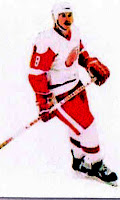One of these talented men of ice figured he could throw a baseball faster then he could shoot a hockey puck and went on to pitch for two teams over an above average 11-year Major League Baseball career - Kirk McCaskill.
Before Kirk McCaskill took the to the mound in his first MLB game in Los Angeles, he skated as a pro hockey prospect in the NHL's Winnipeg Jets farm system in Sherbrooke, Quebec.
 |
| Baseball pitcher Kirk McCaskill playing ice hockey for the AHL's Sherbrooke Jets |
The University of Vermont grad played a full-four year career for the Catamonts from 1979-1983. In 1981, McCaskill's hockey career was taking off. He lead the Catamonts, getting NHL scouts interested in his on-ice prowess, scoring with 51 points in 32 games. The Winnipeg Jets came calling in the summer of that year, drafting McCaskill in the fourth round, #64 overall at the 81 NHL Entry Draft.
It appeared that the Jets had some talent on their hands because by 1982, McCaskill had his finest college season, scoring 30 goals and 49 points, becoming an NCAA All-American first team all star and was a finalist for the Hobey Baker award.
 |
| McCaskill playing for Vermont in 1982 - photo courtesy HistoricImages.com |
By the spring of 1982, McCaskill was keeping his baseball hopes alive by signing a pro contract with the California Angels, playing Class A baseball in Massachuesettes which didn't affect his college eligibility. When the fall came, McCaskill went back to school for the start of the NCAA hockey season. In January 1983, McCaskill left the University of Vermont to join the California Angels spring training camp in Arizona, playing in lower pro baseball leagues over the spring and summer. But he refused to give on the puck dreams and eventually returned to hockey by the fall of 1983 by siging with the Jets.
At Winnipeg's training camp in September 1983, McCaskill failed to impress Jets coaching staff, having head coach and long time pro Barry Long commenting, "McCaskill plays hockey the way he plays baseball - once every four games."
McCaskill was unable to hook on with Winnipeg Jets roster and was sent down to their AHL farm team in Sherbrooke. McCaskill played out the full 1983-1984 year in Sherbrooke, scoring 22 points, with 10 goals and was called up for one NHL game but never was put in the lineup.
 |
| Kirk McCaskill pitching for the Los Angeles Angels in 1991 - photo courtesy Panini America Ltd. |
McCaskill walked away from hockey after his frustrating experience in Winnipeg and devoted himself completely to baseball in 1985. The Kapuskasking, Ontario native made his major league debut in May of 1985, never looking back and finding his way into hockey obscurity.



































